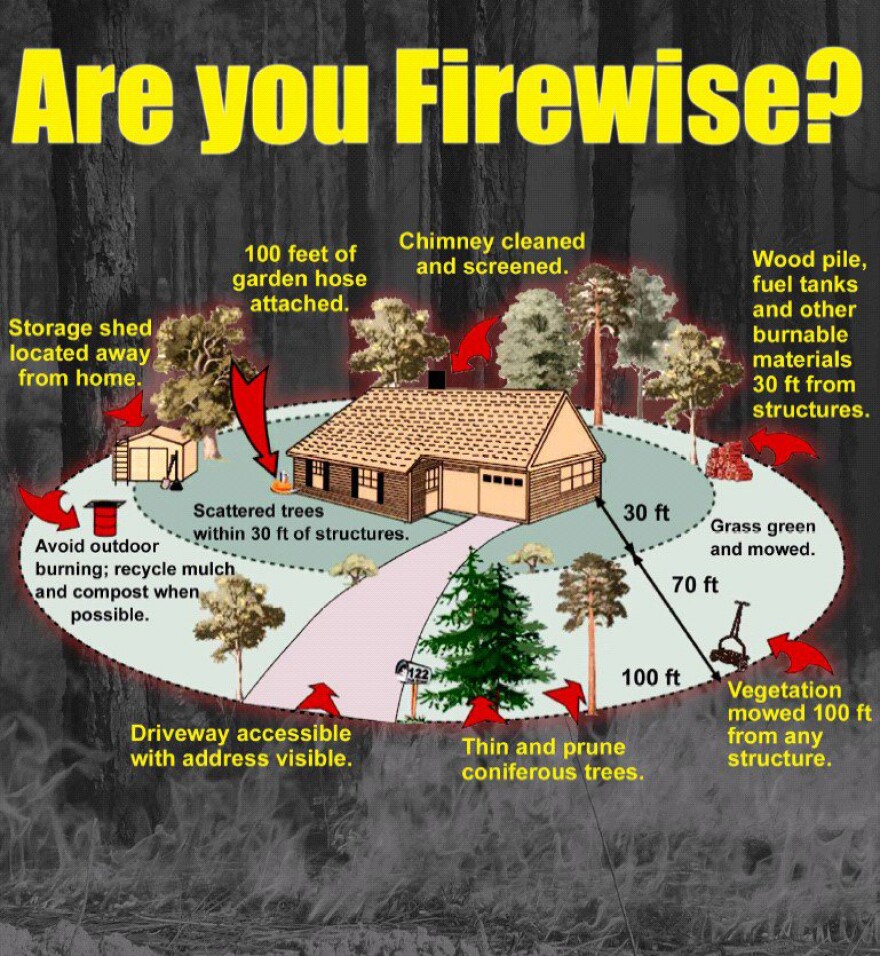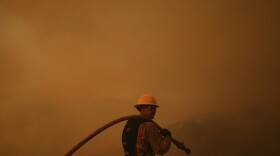As temperatures creep up and fires are starting to pop up, Idaho's wildfire season is just around the corner. From air quality concerns to evacuations, wildfires impact pretty much everyone.
We've rounded up some resources to make sure you're prepared:
- Wildfires in the West right now
- Fire Risk Index
- Outlook maps
- Air quality monitoring
- Power outages
- How to protect your home
- Evacuation tips
- Additional resources
Current wildfires
A new interactive map by the Western Fire Chiefs Association aims to provide the latest information on wildfires in the west. The map shows fires on state and federal land, but the creators hope to fill in gaps by pulling data from 911 dispatch via PulsePoint.
In some rural areas prone to wildfires internet connections can be weak, so they prioritized a map that could load quickly. It can help people know when to evacuate an area or check up on livestock.
Fire Risk Index
The Fire Risk Index compares an area's relative fire risk with that of the entire United States. When assigning the score, FEMA considers three factors:
- Wildfire exposure quantifies a community's building value and population who are at risk of experiencing a wildfire
- Wildfire annualized frequency estimates the number of wildfires that will take place in the community per year
- Historic loss ratio projects the percentage of buildings or population that is expected to be lost in a wildfire
National Significant Wildland Fire Potential Outlooks
The National Interagency Fire Center published its Significant Wildland Fire Potential Outlook maps below to show cumulative wildfire forecasts for June, July, August and September of 2025.
Air quality monitoring
The Idaho Department of Environmental Quality has compiled information on smoke and air quality on its website. Those include:
The Air Quality Index (AQI) is the United States Environmental Protection Agency's index for reporting air quality. The higher the AQI value, the greater the level of air pollution and health concern.
The AQI is divided into six categories and each category corresponds to a different level of health concern.

Power outages
Wildfires can sometimes cause power outages before or during the threat of fire. Preparation ahead of these emergencies helps prioritize safety during an outage in the heat of summer.
Idaho Power suggests putting together a Summer Outage Kit in case you lose power. Here's what they recommend you put in your kit:
- Bottled water (five gallons per person)
- Matches
- Blankets
- Non-perishable food (canned food, crackers, etc.)
- Non-electric can opener
- Baby food or formula and diapers
- Pet food
- First aid kit
- Prescription medications
- Battery- or solar-powered chargers for your devices
- Battery-powered radio and clock, flashlight and fans
- Extra batteries
- A block of ice in the freezer
How to protect your home
In 2024, the United States had 64,897 wildfires, resulting in a total of 4,552 structures being destroyed, according to data from the National Interagency Coordination Center.
Wildfires are often uncontrolled and dangerous, and for a homeowner in a high-risk area, it’s easy to feel helpless in protecting their property. However, homeowners can take action by taking a few safety measures:

If you're still unsure about protecting your home, you can get a free wildfire home safety evaluation from your local fire officials.
How to prepare for evacuation
On average, Idaho's populated areas have a greater wildfire risk than 96% of states in the U.S.
When it comes to evacuations during the threat of wildfire, that puts the emphasis on leaving early to avoid congestion and free up roadways for fire crews and personnel.
Here are some tips for evacuation:
- Have an evacuation bag ready to go
- Shut all windows and doors
- Remove flammable window shades, curtains and close metal shutters
- Move flammable furniture away from windows and doors
- Shut off gas at the meter
- Leave your interior and exterior lights on so firefighters can see your house under smoky conditions
- Shut off the air conditioning
- Gather flammable items outside and bring them inside or place them in a pool if you have one
- Turn off propane tanks
- Move propane appliances away from your home
- Connect garden hoses to outside water valves for fighters to use
- Don't leave sprinklers on or water running, they can affect water pressure
- Find your pets and keep them nearby
- Prepare farm animals for transport and think about moving them to a safe location early
Resources
We also pulled together these key resources where you can find up-to-date information about wildfires.
- Sign up for the Idaho State Alert and Warning System
- Here's a handy glossary of firefighting terms
- InciWeb updates fire information around the country, giving handy info about road closures during the summer travel season.
- The Idaho Department of Lands' site will update Idahoans about fire restrictions on public land.
- The National Interagency Fire Center coordinates fire management teams around the country, and is based in Boise.
-
As Idahoans endure weeks of wildfire smoke each summer, a neurologist is warning that what we breathe doesn't just irritate our lungs — it may be harming our brains as well.
-
A new podcast is telling the story of a group of surfers who trained alongside firefighters and were put to the test when one of California's most destructive wildfires tore through Los Angeles County.
-
Report: State legislators should learn from counterparts across the region as insurance crisis growsAs many homeowners face a growing insurance crisis, state leaders across the region are considering reforms. Two groups have recommendations for them as state legislatures begin convening again.
-
Local elected officials across the region are worried that changes in federal policy are putting their communities at risk from wildfire. But public land agencies say some of the concerns are overstated.
-
New data also points to major insurance impacts in places surprising to many, including the Snake River Plain.
-
The Honoring Our Fallen Heroes Act was introduced by Democratic Minnesota Sen. Amy Klobuchar in January, but has received substantial bipartisan support.
-
As wildfires get more intense, there are questions about how effective prescribed fire and other fuel treatments can be. New research suggests that they can still have real impacts.
-
As our climate changes and wildfires become a larger part of living in the West, one local artist’s work looks at our relationship with changing landscapes.
-
Brian Fennessy has nearly 50 years of fire experience, which began in the late 1970s on elite federal hotshot crews and other wildfire teams.
-
Momentum is building toward deployment of respirators to protect wildland firefighters from a long list of toxins. But researchers argue that the workforce’s practical concerns would need to be addressed for implementation to be successful.















